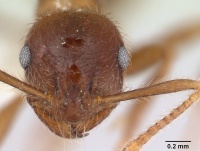Kartidris
| Kartidris | |
|---|---|

| |
| Kartidris nyos | |
| Scientific classification | |
| Kingdom: | Animalia |
| Phylum: | Arthropoda |
| Class: | Insecta |
| Order: | Hymenoptera |
| Family: | Formicidae |
| Subfamily: | Myrmicinae |
| Tribe: | Crematogastrini |
| Alliance: | Mayriella genus group |
| Genus: | Kartidris Bolton, 1991 |
| Type species | |
| Kartidris nyos | |
| Diversity | |
| 6 species (Species Checklist, Species by Country) | |
Identification
Kartidris belongs in the Pheidole-Aphaenogaster-Messor-group of genera, characterized by the high-domed pronotum, elongate sloping mesothorax, anteriorly situated petiolar spiracle, and propodeal spiracle located high on the side and close to the midlength. The mandible of Kartidris is specialized by reduction in the number of teeth and the median portion of the clypeus is markedly biconvex.
| See images of species within this genus |
Keys including this Genus
Distribution
Distribution and Richness based on AntMaps
Species by Region
Number of species within biogeographic regions, along with the total number of species for each region.
| Afrotropical Region | Australasian Region | Indo-Australian Region | Malagasy Region | Nearctic Region | Neotropical Region | Oriental Region | Palaearctic Region | |
|---|---|---|---|---|---|---|---|---|
| Species | 0 | 0 | 0 | 0 | 0 | 0 | 3 | 5 |
| Total Species | 2851 | 1736 | 3047 | 932 | 840 | 4391 | 1767 | 2925 |
Biology
Life History Traits
- Mean colony size: 16-52 (Greer et al., 2021)
- Compound colony type: not parasitic (Greer et al., 2021)
- Nest site: hypogaeic (Greer et al., 2021)
- Diet class: ? (Greer et al., 2021)
- Foraging stratum: subterranean/leaf litter (Greer et al., 2021)
Castes
Morphology
Worker Morphology
 Explore: Show all Worker Morphology data or Search these data. See also a list of all data tables or learn how data is managed.
Explore: Show all Worker Morphology data or Search these data. See also a list of all data tables or learn how data is managed.
• Eyes: 11-100 ommatidia • Pronotal Spines: absent • Mesonotal Spines: absent • Propodeal Spines: absent • Petiolar Spines: absent • Caste: none or weak • Sting: present • Metaplural Gland: present • Cocoon: absent
Phylogeny
| Myrmicinae |
| ||||||||||||||||||||||||||||||||||||||||||||||||||||||||||||||||||||||||||||||||||||||||||||||||||||||||||||||||||||||||||||||||||||||||||||||||||||||||||||||||||||||||||||||||||||||||||||||||||||||||||||||||||||||||||||||||||||||||||||||||||||||||||||||||||||||||||||||||||||||||||||||||||||||||||||||||||||||||||||||||||||||||||||||||||||||||||||||||||||||||||||||||||||||||||||||||||||||||||||||||||||||||||||||||||||||||||||||||||||||||||||||||||||||||||||||||||||||||||||||||||||||||||||||||||||||||||||||||||||||||||||||||||||||||||||||||||||||||||||||||||||||||||||||||||||||||||||||||||||||||||||||||||||||||||||||||||||||||||||||||||||||||||||||||||||||||||||||||||||||||||||||||||||||||||||||||||||||||||||||||||||||||||||||||||||||||||||||||||||||||||||||||||||||||||||||||||||||||||||||||||||||||||||||||||||||||||||||||||||||||||||||||||||||||||||||||||||||||||||||||||||||||||||||||||||
See Phylogeny of Myrmicinae for details.
Nomenclature
The following information is derived from Barry Bolton's Online Catalogue of the Ants of the World.
- KARTIDRIS [Myrmicinae: Pheidolini]
- Kartidris Bolton, 1991: 10. Type-species: Kartidris nyos, by original designation.
Diagnosis of worker. Monomorphic terrestrial myrmicine ants with the following combination of characters.
1. Palp formula 4, 3.
2. Mandible triangular, usually with 5 sharp teeth which decrease in size from apex to base; sometimes with a denticle following the third tooth, giving a total dental count of 6.
3. Anterior clypeal margin with a row of stout setae, lacking an isolated median seta.
4. Median portion of clypeus broad and biconvex, posteriorly broadly inserted between the frontal lobes.
5. Frontal lobes relatively narrow, each lobe narrower than the portion of the clypeus which is inserted between them.
6. Torulus projecting beyond margin of frontal lobe, visible in full-face view.
7. Frontal carinae and antennal scrobes absent.
8. Eyes of moderate size, positioned behind the midlength of the sides of the head.
9. Antennae 12-segmented, with a conspicuous 3-segmented apical club.
10. Occipital margin convex and vertex with a broad depressed area between the eyes, depression conspicuous in profile.
11. Alitrunk elongate, the pronotum forming a raised dome in profile behind which the mesonotum forms a long gradual slope to the meta notal groove.
12. Metanotal groove impressed; propodeum unarmed and rounded.
13. Propodeal spiracle high on side, located at or just in front of the midlength of the sclerite.
14. Metapleurallobes vestigial to absent.
15. Metapleural gland bulla large but widely separated from the propodeal spiracle.
16. Metasternal process vestigial to absent.
17. Tibial spurs absent from middle and hind legs or at least not distinguishable from the surrounding pilosity.
18. Petiole pedunculate, the spiracle located at or just in front of the midlength of the peduncle.
19. Postpetiolar sternite large and conspicuous.
20. Sting reduced and desclerotized, excertile but subspatulate apically.
21. Cuticle thick and strong, sculpture weak. Pilosity abundant; eyes with projecting short hairs.
References
- Blaimer, B.B., Ward, P.S., Schultz, T.R., Fisher, B.L., Brady, S.G. 2018. Paleotropical diversification dominates the evolution of the hyperdiverse ant tribe Crematogastrini (Hymenoptera: Formicidae). Insect Systematics and Diversity 2(5): 3; 1-14 (doi:10.1093/isd/ixy013).
- Bolton, B. 1991. New myrmicine genera from the Oriental Region (Hymenoptera: Formicidae). Syst. Entomol. 16: 1-13. (page 10, Kartidris in Myrmicinae, Pheidolini; page 12, Key to species)
- Bolton, B. 1994. Identification guide to the ant genera of the world. Cambridge, Mass.: Harvard University Press, 222 pp. (page 106, Kartidris in Myrmicinae, Pheidolini)
- Bolton, B. 1995a. A taxonomic and zoogeographical census of the extant ant taxa (Hymenoptera: Formicidae). J. Nat. Hist. 2 29: 1037-1056 (page 1050, Kartidris in Myrmicinae, Pheidolini)
- Bolton, B. 1995b. A new general catalogue of the ants of the world. Cambridge, Mass.: Harvard University Press, 504 pp. (page 219, Kartidris in Myrmicinae, Pheidolini)
- Bolton, B. 2003. Synopsis and Classification of Formicidae. Mem. Am. Entomol. Inst. 71: 370pp (page 231, Kartidris in Myrmicinae, Pheidolini)
- Cantone S. 2018. Winged Ants, The queen. Dichotomous key to genera of winged female ants in the World. The Wings of Ants: morphological and systematic relationships (self-published).
- Greer, J. A., Moreau, C. S. 2021. Phylogenetic analysis and trait evolution of ant cocoons. Insect Systematics & Evolution 53(1), 60–77 (doi:10.1163/1876312x-bja10008).
- Xu, Z. 1999a. Systematic studies on the ant genera of Carebara, Rhopalomastix and Kartidris in China (Hymenoptera: Formicidae: Myrmicinae). Acta Biol. Plateau Sin. 14: 129-136 (page 134, all species key)

